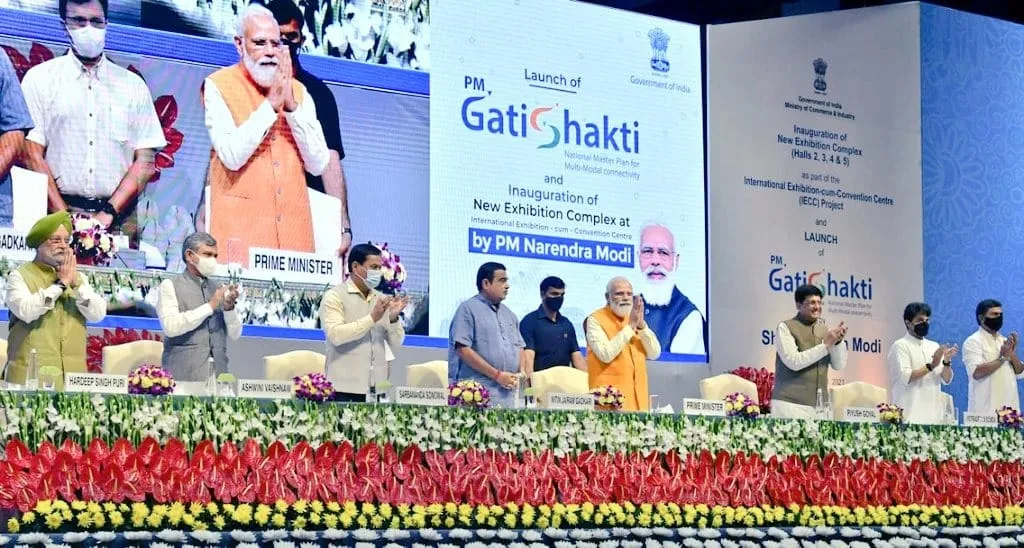Gati Shakti National Master plan launched in October 2021 is essentially a digital platform to bring 16 ministers including railways and Roadways together. This is being done for integrated planning and coordinated implementation of infrastructure connectivity projects.
Aims of the project
The objective of the Gati Shakti National Master Plan was to assist different ministries in planning for projects after the identification of critical gaps. Gati Shakti helps in the synchronization of the activities of each department as well as different layers of governance, in a holistic manner by ensuring the coordination of work between them.

It also considers the upkeep of various “Economic Zones” like textile clusters, industrial corridors, fishing clusters, electronic parks, defense corridors, and agricultural zones in order to improve connectivity, boost the competitiveness of Indian businesses, and significantly lower the cost of logistics.
Read more: Prime Minister to launch PM GatiShakti on 13th October
Effects of roadways construction
Infrastructure development and highway construction cannot be evaded since it has a significant impact on the economic development of any nation. However, the construction of highways and railways has its own environmental implications. According to studies, they take up valuable areas and distort the ecosystem functions. It also affects the groundwater and river flow. Roadways are also associated with high mortality rates, habitat fragmentation and alterations, and pollution.
Read more: Impact of Road Construction Projects on Residential Buildings In Imo State
A study carried out by the World Bank showed that involuntary resettlement under development projects, if unmitigated, often leads to severe socio-economic and environmental risks, which may bring about failure in production systems. As the construction projects are being carried out, the affected households are displaced to different areas which may have an impact on their unique method of production.
Read more: Roads: Their Environmental Impact | EnvironmentalScience.org
Proposed and ongoing projects
In February 2022, as part of the PM Gati Shakti NMP, the Ministry of Road Transport and Highways proposed to develop
- 22 Greenfield Expressways,
- 23 other key infrastructure projects & other highway projects
- and 35 Multi-Modal Logistics Parks (MMLPs), as part of the Bharatmala Pariyojana and other schemes of the Ministry.
Some of the major Expressways and Corridors, which are under construction stage are:
- Delhi – Mumbai Expressway,
- Ahmedabad-Dholera Expressway,
- Delhi-Amritsar-Katra Expressway,
- Bengaluru-Chennai Expressway,
- Ambala-Kotputli Expressway,
- Amritsar-Bhatinda-Jamnagar Expressway,
- Raipur-VZG Expressway,
- Hyderabad-VZG Expressway,
- UER II,
- Chennai-Salem Expressway and,
- Chittor-Thatchur Expressway.
Some of the major key infrastructure projects, which are under construction stage include the construction of the
- Zojila Tunnel (Ladakh),
- roads to connect Krishnapatnam Port (Andhra Pradesh),
- a major bridge over Middle Strait Creek (Andaman & Nicobar Islands),
- 2-laning of Lalpul-Manmao changing road (Arunachal Pradesh),
- 6-lane bridge over the Ganga bridge at Phaphamau (UP) and
- 4-lane bridge over the Brahmaputra between Dhubri-Phulbari (Meghalaya).
Read More
- National Mission on Sustainable Agriculture, Explained!
- National Mission On Sustainable Habitat, Explained!
- National water mission, Explained!
- National Mission for Sustaining the Himalayan Ecosystem, Explained!
Follow Ground Report for Climate Change and Under-Reported issues in India. Connect with us on Facebook, Twitter, Koo App, Instagram, Whatsapp and YouTube. Write us on GReport2018@gmail.com.









